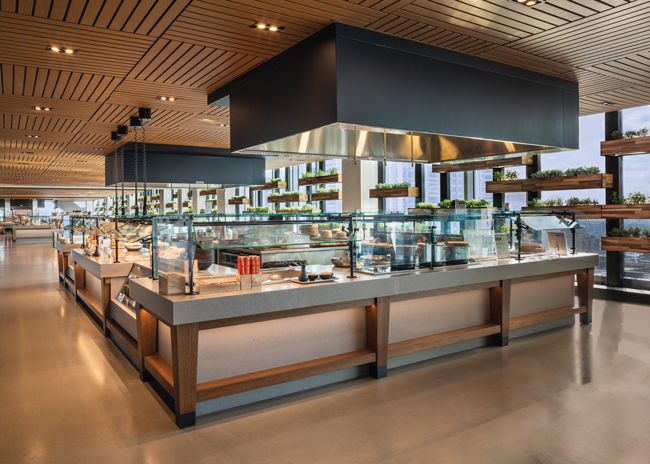While most restaurants have been open in some capacity for months, other foodservice operations, such as corporate feeders and school cafeterias, are just starting to reopen.
 At one corporate feeder, adjustable food guard panels allow for easy conversion from self- to full-serve stations. Comcast Technology and Innovation Center Photos courtesy of “The Market,” photos by Randy Van DuinenServing meals from these kitchens again takes more than simply flipping a switch, though. With equipment idle for months, operators must take several steps to get these items up and running again.
At one corporate feeder, adjustable food guard panels allow for easy conversion from self- to full-serve stations. Comcast Technology and Innovation Center Photos courtesy of “The Market,” photos by Randy Van DuinenServing meals from these kitchens again takes more than simply flipping a switch, though. With equipment idle for months, operators must take several steps to get these items up and running again.
According to John Thorpe, branch manager for Commercial Parts & Service, a service agency based out of Cincinnati, Ohio with branches in Columbus and Dayton, one of the most important steps is also the most straightforward: clean the equipment.
During the cleaning process, Thorpe says, operators should keep an eye out for a number of problems, ranging from insects and rodents that have made a home in unused equipment to blockages in components like burners and pilot lights. Once clean, it becomes time to start the individual pieces and see how they perform.
“That is going to be the biggest sign. When you plug it in, does it run,” says Thorpe. “You may not have any issue with anything, but the sooner you can get in there and light the pilots, bleed the gas lines — all the things the end-user can do before they call us — the better.”
If all the equipment in the kitchen seems to run well, it’s up to the operator to decide if a service call is necessary. Some operators may still want planned maintenance performed, including checking on things like gas and water pressure. Others may be comfortable moving forward.
If equipment shows problems after a cleaning, though, a service agent will need to come out. When requesting service, operators should explain the problems and communicate if any particularly higher-tech pieces of equipment need servicing, such as combi ovens or blast chillers. Those, says Thorpe, can require more highly trained technicians.
Operators should also keep a realistic schedule for service and repair in mind. Thorpe recommends calling at least a week ahead of opening to get on the service agent’s calendar and leave time for repairs. “If we get out there two days before a kitchen is going to open and I need a part, you are running out of time at that point,” he says.
Parts, in fact, can be one of the trickier aspects of service at this time, adds Thorpe. With supply chains stretched thin, some components that previously could be shipped overnight can now take several weeks to source.
The potential for this sort of delay increases the value of working with a Commercial Food Equipment Service Association-certified service agency, Thorpe says. Such firms have relationships with manufacturers and may be able to speed up part delivery in some situations.
Working with established service companies during a restart offer other benefits, Thorpe adds. Many operations laid off or furloughed employees during the pandemic. These operators may now be restarting with staffers who haven’t been trained on a kitchen’s particular equipment. Well-trained service agents should be able to help get these employees up to speed.
“We can absolutely come out, fire stuff up and give a brief overview of a piece of equipment. If someone is not necessarily familiar with how their steamer operates, our technicians can go over the operations and proper maintenance. If there's a piece of equipment that needs a regular descaling or needs to go through a cleaning cycle every night, they can go over a lot of those protocols,” says Thorpe.
Restarting a kitchen that has been shut down for several months is not overly complicated, but it does take some forethought. By planning ahead and choosing the right partner, operators can help the process go as smoothly as possible.



